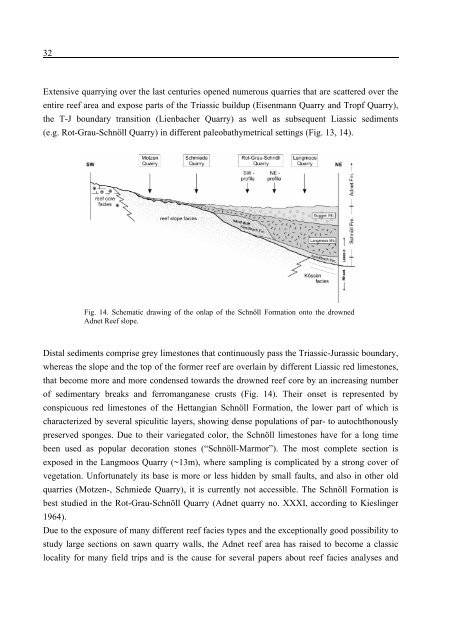Porifera-microbialites of the Lower Liassic (Northern Calcareous ...
Porifera-microbialites of the Lower Liassic (Northern Calcareous ...
Porifera-microbialites of the Lower Liassic (Northern Calcareous ...
You also want an ePaper? Increase the reach of your titles
YUMPU automatically turns print PDFs into web optimized ePapers that Google loves.
32<br />
Extensive quarrying over <strong>the</strong> last centuries opened numerous quarries that are scattered over <strong>the</strong><br />
entire reef area and expose parts <strong>of</strong> <strong>the</strong> Triassic buildup (Eisenmann Quarry and Tropf Quarry),<br />
<strong>the</strong> T-J boundary transition (Lienbacher Quarry) as well as subsequent <strong>Liassic</strong> sediments<br />
(e.g. Rot-Grau-Schnöll Quarry) in different paleobathymetrical settings (Fig. 13, 14).<br />
Distal sediments comprise grey limestones that continuously pass <strong>the</strong> Triassic-Jurassic boundary,<br />
whereas <strong>the</strong> slope and <strong>the</strong> top <strong>of</strong> <strong>the</strong> former reef are overlain by different <strong>Liassic</strong> red limestones,<br />
that become more and more condensed towards <strong>the</strong> drowned reef core by an increasing number<br />
<strong>of</strong> sedimentary breaks and ferromanganese crusts (Fig. 14). Their onset is represented by<br />
conspicuous red limestones <strong>of</strong> <strong>the</strong> Hettangian Schnöll Formation, <strong>the</strong> lower part <strong>of</strong> which is<br />
characterized by several spiculitic layers, showing dense populations <strong>of</strong> par- to autochthonously<br />
preserved sponges. Due to <strong>the</strong>ir variegated color, <strong>the</strong> Schnöll limestones have for a long time<br />
been used as popular decoration stones (“Schnöll-Marmor”). The most complete section is<br />
exposed in <strong>the</strong> Langmoos Quarry (~13m), where sampling is complicated by a strong cover <strong>of</strong><br />
vegetation. Unfortunately its base is more or less hidden by small faults, and also in o<strong>the</strong>r old<br />
quarries (Motzen-, Schmiede Quarry), it is currently not accessible. The Schnöll Formation is<br />
best studied in <strong>the</strong> Rot-Grau-Schnöll Quarry (Adnet quarry no. XXXI, according to Kieslinger<br />
1964).<br />
Fig. 14. Schematic drawing <strong>of</strong> <strong>the</strong> onlap <strong>of</strong> <strong>the</strong> Schnöll Formation onto <strong>the</strong> drowned<br />
Adnet Reef slope.<br />
Due to <strong>the</strong> exposure <strong>of</strong> many different reef facies types and <strong>the</strong> exceptionally good possibility to<br />
study large sections on sawn quarry walls, <strong>the</strong> Adnet reef area has raised to become a classic<br />
locality for many field trips and is <strong>the</strong> cause for several papers about reef facies analyses and

















